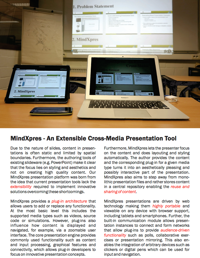
MindXpres is a research project of the WISE research group at the Vrije Universiteit Brussel, Belgium. MindXpres was developed as a rapid prototyping platform for implementing and evaluating innovative presentation-related ideas that go beyond the features offered by existing presentation tools. We are currently working on making MindXpres available to the general public in order that everyone can make use of the research-backed features that we have developed based on the platform so far.
Due to the nature of slides, content in presentations is often static and restricted by spatial boundaries. Furthermore, existing slideware (e.g. PowerPoint) authoring tools focus on styling and aesthetics rather than on creating high quality content. Our MindXpres presentation platform was born from the idea that current presentation tools lack the necessary extensibility for implementing innovative solutions that overcome these shortcomings.
MindXpres provides a plug-in architecture that allows users to add or replace any functionality. At the most basic level this includes the supported media types such as videos, source code or simulations. However, plug-ins can also be used to define how content is displayed and navigated (e.g. via a zoomable user interface). The core MindXpres presentation engine provides commonly used functionality such as content and input processing, graphical features and connectivity, which allows plug-in developers to focus on innovative presentation concepts.
Furthermore, MindXpres lets the user focus on the content while automatically dealing with the layouting and styling. The author provides the content and the corresponding plug-in for a given media type turns it into an aesthetically pleasing and possibly interactive part of the presentation. MindXpres also aims to step away from monolithic presentation files and rather stores content in a central repository enabling the reuse and sharing of content.
MindXpres presentations are driven by web technology which makes them highly portable and viewable on any device with browser support, including tablets and smartphones. Further, the built-in communication module allows presentation instances to connect and form networks that enable plug-ins to provide audience-driven functionality such as polls, collaborative exercises or presentation mirroring. This also enables the integration of arbitrary devices such as clickers or digital pens which can be used for input and navigation.


